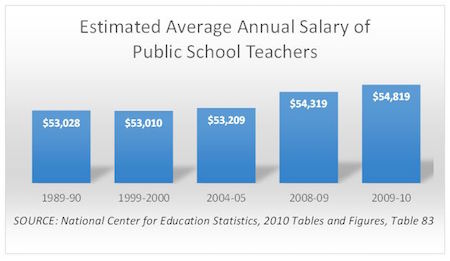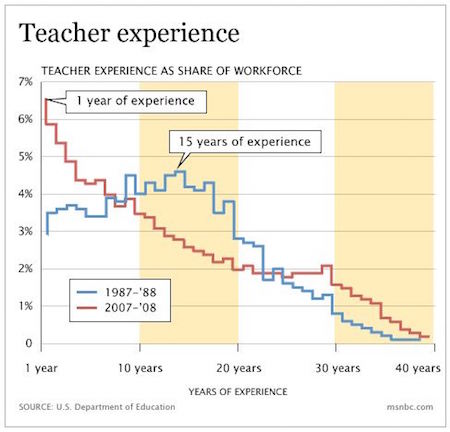
Worried about teacher salaries? You’re in good company. Concerns that American salaries have stagnated span sectors – and, like most economic qualms, those concerns are particularly relevant in an election year. Educators are no different. In her July 5 remarks to the National Education Association, Hillary Clinton told teachers, “we need to be serious about raising your pay…no educator should have to take second and third jobs just to get by.”
While Clinton is right to note stagnant teacher pay, policymakers need to think carefully about next steps. We’ve argued that pensions play a role in eating up budget resources that could be used for teacher salary increases, but there are other trends in the composition of the teaching workforce that may be leading us to the wrong conclusions on teacher wages (and these trends extend beyond education). If our diagnosis is off, our policy solutions may fall short as well.
Data from the U.S. Department of Education show average teacher salaries have stalled in the last two decades. The chart below, adjusted for inflation, shows the average teacher makes just $1,791 more in 2009 than in 1989.

At first glance, it looks like teacher wages are relatively flat. But what if that isn’t the whole story?
The previous graph shows little change in average teacher pay, but that says nothing about individual teachers. Indeed, each individual teacher is paid according to local salary schedules, which tend to give increases as teachers age into the workforce. And, although salary schedules were frozen in many districts in the wake of the last recession, individual teachers continued to move along those schedules and earn annual raises.
But average salaries also depend on the distribution of teachers at each step on district salary schedules. If the teacher workforce looked exactly the same today as it did in the past, this wouldn’t matter. But the teacher workforce has changed over time, and teacher experience levels today look dramatically different than what they did 20 or 30 years ago. If you asked a teacher in 1988 how many years of experience he or she had, you’d be most likely to hear 15 years. If you did the same in 2008, the most common answer would have been one year of experience. The numbers have shifted a bit since 2008, partly in response to a fall in teacher hiring in the wake of the last recession, but there are still far more new teachers in the classroom than there were two decades ago.

This shift—from a veteran-dominated profession to one more heavily tilted toward newcomers—also has implications for calculating average teacher salaries. Because veteran teachers earn higher salaries than less experienced teachers, changing teacher experience levels account for some of the stagnation in overall teacher salaries.
Even if, like me, you agree with Secretary Clinton that teachers should be paid more, it’s important to understand the forces behind it before devising policy solutions that can solve it.
What’s interesting is we may already be past this trend. The teaching workforce, like many other occupations, aged throughout the 1990s and 2000s and is now starting to fall as the Baby Boom generation of teachers retire. As a new crop of teachers age into the workforce, earn higher salaries, and slowly take their place as the dominant group in schools, the trends may reverse, and we may start to see demographics artifically inflating average salaries. No policy would have changed, but our understanding of how well we pay our teachers will have.
—Kirsten Schmitz
Kirsten Schmitz is an Analyst with Bellwether Education Partners. This post originally appeared on TeacherPensions.org


